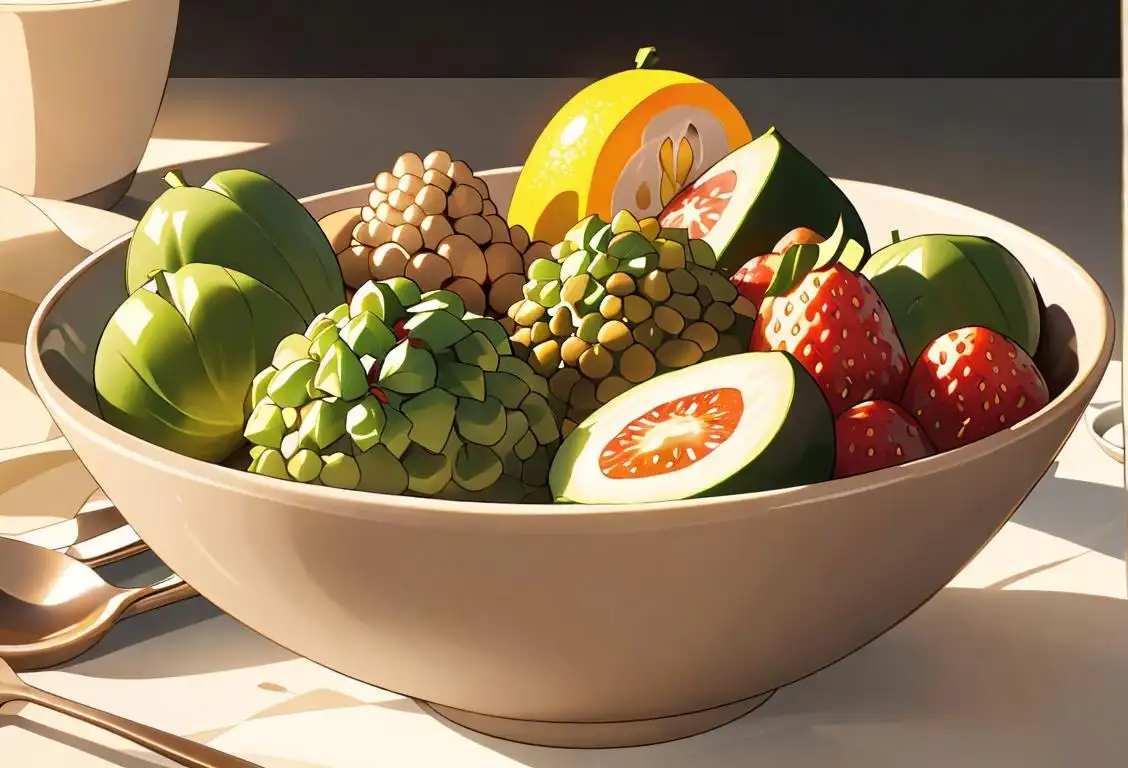National Chia Day

Welcome to National Chia Day! Get ready to embrace the tiny but mighty chia seed and all its greatness. This special day celebrates the nutritional powerhouse that has become a favorite among health-conscious individuals. So, buckle up and let's dive into the fascinating world of chia seeds!
When is Chia Day?
It's national chia day on the 23rd March.
A Brief History of Chia Seeds on the Internet
Chia seeds have a long and illustrious history, dating back centuries to the Mayan and Aztec civilizations. These ancient cultures recognized the incredible health benefits of chia seeds, which were often referred to as 'running food' due to their ability to provide sustained energy. Fast forward to the internet age, and chia seeds have become a sensation.
On March 23, 2016, the internet exploded with chatter about chia seeds, bringing National Chia Day into existence. With a whopping 131 online mentions, it was quite the digital frenzy. People couldn't stop talking about the versatile seed and the countless ways it could be incorporated into recipes, from smoothies and puddings to baked goods and salads.
Since then, National Chia Day has been celebrated every year as a reminder of the seed's numerous health benefits and its surprisingly delicious taste.
How to Celebrate National Chia Day
There are endless ways to celebrate National Chia Day and pay tribute to the superfood that is chia seeds. Here are a few ideas to get you started:
- Try making a chia seed pudding for breakfast. Mix chia seeds with your favorite nut milk, add some sweetener and flavorings, refrigerate overnight, and wake up to a delightful and nutritious treat.
- Add chia seeds to your smoothies for an extra boost of fiber and omega-3 fatty acids.
- Bake some chia seed-infused goodies, such as cookies or muffins, and share them with your loved ones. Who can resist a healthy and tasty treat?
- Host a chia seed recipe swap with friends or family. Each person can bring their favorite chia recipe, and everyone gets to taste and discover new culinary delights.
- Get active and participate in a chia-themed sports event. Okay, we might have made that one up, but it could be a fun way to get moving and show off your chia seed enthusiasm.
Did You Know?
Did you know that chia seeds can absorb up to 10 times their weight in liquid? It's true! When mixed with water or other liquids, chia seeds form a gel-like substance, making them perfect for creating thick and creamy recipes like puddings.
History behind the term 'Chia'
3000 BCE
Ancient Roots
Chia seeds have ancient origins, dating back to 3000 BCE. The word 'chia' itself is derived from the Mayan language, where 'chiabaan' means 'strength.' The Mayans and Aztecs both recognized the tremendous nutritional value of chia seeds and regularly used them as a staple in their diets. Chia seeds were highly regarded for their ability to provide sustainable energy and endurance.
1500 BCE
Ancient Origins
Chia seeds have been consumed by ancient civilizations dating back to 1500 BCE. The word 'chia' comes from the Nahuatl word 'chian,' which means 'oily,' referring to the high oil content of the seeds. Ancient Aztecs and Mayans considered chia seeds a staple food and a valuable energy source.
3500 BCE
Ancient Origins
The term 'chia' traces its origins back to 3500 BCE, in the ancient civilizations of Mesoamerica. Chia seeds come from the plant called Salvia hispanica, which is native to Mexico and Guatemala. The word 'chia' is derived from the Nahuatl language, spoken primarily by the Aztecs. In Nahuatl, 'chia' means 'oily,' referring to the high oil content of the seeds.
1500 BCE
Ancient Origins
Chia, scientifically known as Salvia hispanica, was cultivated as a food crop by the Aztecs and Mayans in Mesoamerica around 1500 BCE. These ancient civilizations recognized the nutritional value of chia seeds and incorporated them into their diets for sustenance and endurance.
16th Century
Spanish Encounter
During the Spanish conquest of the Americas in the 16th century, chia seeds gained attention from the Europeans. They recognized the nutritional benefits and potential health properties of chia seeds. The Spanish explorers introduced chia to Europe, and it gradually spread throughout other parts of the world.
1500s
Aztec Superfood
During the 1500s, chia became a staple food for the Aztecs and other indigenous cultures in the region. This nutrient-dense crop was highly valued for its long-lasting energy and medicinal properties. In fact, chia seeds were thought to provide supernatural powers and were often offered as tributes to religious deities. The Aztecs praised chia seeds for their ability to enhance stamina and mental agility.
1593
Spanish Conquerors Encounter Chia
During the Spanish conquest of the Americas, chia seeds were introduced to the European explorers. In 1593, Spanish botanist Francisco Hernandez documented the usage of chia seeds by indigenous communities in what is now modern-day Mexico. This encounter with chia seeds sparked interest among Europeans, who began to recognize their incredible nutritional qualities.
16th Century
Spanish Conquest
During the Spanish conquest of the Americas in the 16th century, chia seeds gained attention from European explorers. They marveled at the incredible endurance of Indigenous peoples and noted that chia was a crucial part of their diet. This discovery marked the first encounter between Europeans and chia seeds.
1980s
Chia's Popularity Revived
After centuries of relative obscurity, chia experienced a resurgence in popularity during the 1980s. Health-conscious individuals rediscovered the exceptional nutritional benefits of these tiny seeds. Chia seeds became a prominent ingredient in various health products, including energy bars, smoothies, and puddings, due to their high omega-3 fatty acid content, fiber, and antioxidants.
1700s
Spanish Conquest and Decline
With the arrival of the Spanish conquistadors in the 16th century, the cultivation and consumption of chia diminished. The Spanish colonizers suppressed indigenous practices and crops, replacing them with European alternatives. As a result, the knowledge and popularity of chia seeds declined, becoming a lost treasure for many centuries.
Late 20th Century
Rediscovery and Modern Usage
Chia experienced a resurgence in popularity during the late 20th century due to its nutritional profile. The seeds are rich in omega-3 fatty acids, fiber, protein, and various micronutrients. Health enthusiasts and nutritionists began incorporating chia seeds into their diets, considering them a superfood.
20th Century
Rediscovery and Modern Cultivation
Chia seeds remained relatively unknown outside of Mesoamerica until the early 20th century when their nutritional benefits captured the interest of scientists and health enthusiasts. Researchers rediscovered chia and recognized its potential as a rich source of omega-3 fatty acids, fiber, and antioxidants. Modern cultivation methods were developed, leading to increased production and availability of chia seeds worldwide.
2009
Chia Pet Phenomenon
In 2009, the 'Chia Pet' reached significant popularity as a novelty item. Chia seeds were used to grow plants on terracotta figurines, delighting both children and adults. The Chia Pet became a cultural icon, representing the nostalgic value and quirky nature of chia seeds.
1990s
Rediscovery and Modern Resurgence
In the 1990s, chia experienced a remarkable resurgence in popularity as its nutritional benefits were recognized by health enthusiasts. Chia seeds gained attention for being a rich source of omega-3 fatty acids, fiber, protein, and various micronutrients. Their ability to absorb liquid and form a gel-like consistency when soaked made them a versatile ingredient in culinary creations like puddings, smoothies, and baked goods.
2012
Chia Seeds Go Mainstream
In 2012, chia seeds entered the mainstream health food market. The publication of the best-selling book 'Born to Run,' in which the Tarahumara tribe in Mexico utilized chia seeds for endurance running, further popularized their use among athletes and fitness enthusiasts. Chia seeds gained a reputation as a 'superfood' due to their versatility and nutritional richness.
21st Century
Rise in Popularity
In recent years, chia has skyrocketed in popularity as a superfood. Its exceptional nutritional profile, including its high protein content, omega-3 fatty acids, and fiber, has made it a sought-after ingredient in health-conscious diets. Chia seeds are now commonly used in various culinary applications, such as smoothies, puddings, and baked goods, and have become a staple in the healthy eating movement.
Present Day
Diverse Usage and Culinary Applications
Currently, chia seeds are widely used in various culinary applications. They are popular as a topping for smoothies, puddings, and yogurt. Chia seeds are also frequently incorporated into baked goods, energy bars, and gluten-free recipes. Additionally, they serve as a vegan substitute for eggs in some recipes due to their ability to gel when combined with liquid.
Present
Chia Goes Global
Today, chia seeds have become a global superfood, embraced by health-conscious individuals worldwide. Their popularity extends beyond the culinary realm, as chia seeds are also used in skincare products and animal feed. Whether consumed for their nutritional value or utilized for their unique textural properties, chia seeds have firmly established themselves in contemporary diets and lifestyles, enriching the global cultural tapestry.
Present
Chia Seeds Enjoy Continued Popularity
Today, chia seeds are widely recognized as a nutritious addition to a balanced diet. They are commonly used in baking, cooking, and as a topping for smoothie bowls and yogurt. Chia seeds have become a popular choice among vegetarians, vegans, and health-conscious individuals seeking plant-based sources of protein, fiber, and healthy fats. The term 'chia' has become synonymous with a healthy lifestyle and mindful eating.
Did you know?
Did you know that chia seeds can absorb up to 10 times their weight in liquid? It's true! When mixed with water or other liquids, chia seeds form a gel-like substance, making them perfect for creating thick and creamy recipes like puddings.Tagged
romance awareness food fun loved onesFirst identified
23rd March 2016Most mentioned on
23rd March 2016Total mentions
131Other days
Family Day
Action Day
Awareness Day
One Day
Opposite Day
Vodka Boyfriend Day
Kissing Fried Chicken Day
Happiness Day
Suicide Prevention Month Day
Believe Day









